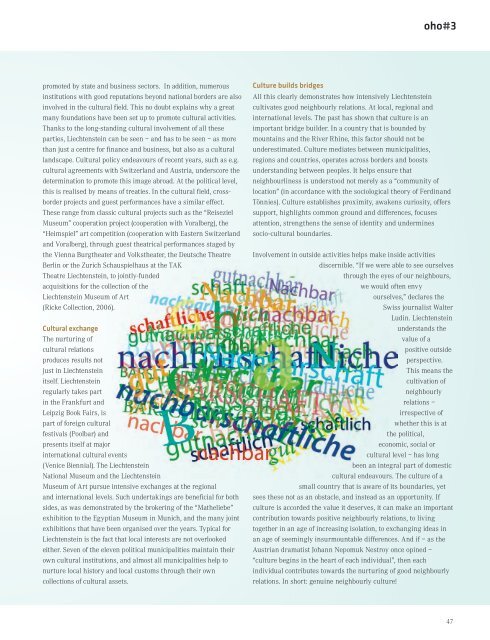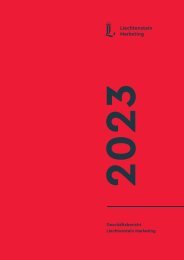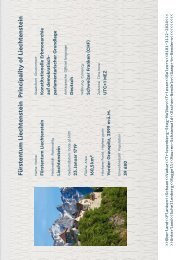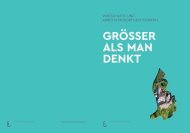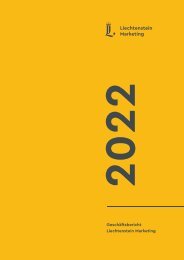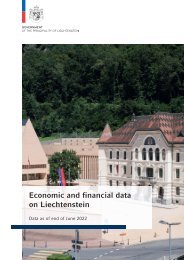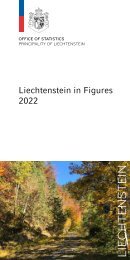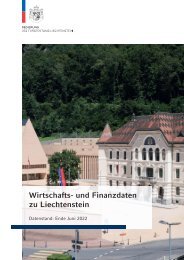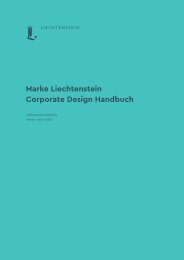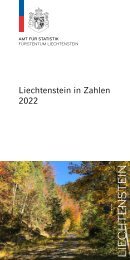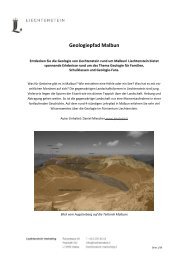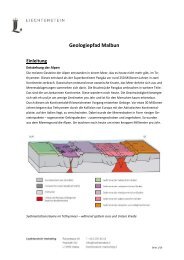oho #3 - The magazine of the Principality of Liechtenstein
The Liechtenstein magazine takes you onto a journey through the country. Find out more about the state, the Princely House, the nature, the culture, the economy and more.
The Liechtenstein magazine takes you onto a journey through the country. Find out more about the state, the Princely House, the nature, the culture, the economy and more.
You also want an ePaper? Increase the reach of your titles
YUMPU automatically turns print PDFs into web optimized ePapers that Google loves.
<strong>oho</strong><strong>#3</strong><br />
promoted by state and business sectors. In addition, numerous<br />
institutions with good reputations beyond national borders are also<br />
involved in <strong>the</strong> cultural field. This no doubt explains why a great<br />
many foundations have been set up to promote cultural activities.<br />
Thanks to <strong>the</strong> long-standing cultural involvement <strong>of</strong> all <strong>the</strong>se<br />
parties, <strong>Liechtenstein</strong> can be seen – and has to be seen – as more<br />
than just a centre for finance and business, but also as a cultural<br />
landscape. Cultural policy endeavours <strong>of</strong> recent years, such as e.g.<br />
cultural agreements with Switzerland and Austria, underscore <strong>the</strong><br />
determination to promote this image abroad. At <strong>the</strong> political level,<br />
this is realised by means <strong>of</strong> treaties. In <strong>the</strong> cultural field, crossborder<br />
projects and guest performances have a similar effect.<br />
<strong>The</strong>se range from classic cultural projects such as <strong>the</strong> “Reiseziel<br />
Museum” cooperation project (cooperation with Voralberg), <strong>the</strong><br />
“Heimspiel” art competition (cooperation with Eastern Switzerland<br />
and Voralberg), through guest <strong>the</strong>atrical performances staged by<br />
<strong>the</strong> Vienna Burg<strong>the</strong>ater and Volks<strong>the</strong>ater, <strong>the</strong> Deutsche <strong>The</strong>atre<br />
Berlin or <strong>the</strong> Zurich Schauspielhaus at <strong>the</strong> TAK<br />
<strong>The</strong>atre <strong>Liechtenstein</strong>, to jointly-funded<br />
acquisitions for <strong>the</strong> collection <strong>of</strong> <strong>the</strong><br />
<strong>Liechtenstein</strong> Museum <strong>of</strong> Art<br />
(Ricke Collection, 2006).<br />
Cultural exchange<br />
<strong>The</strong> nurturing <strong>of</strong><br />
cultural relations<br />
produces results not<br />
just in <strong>Liechtenstein</strong><br />
itself. <strong>Liechtenstein</strong><br />
regularly takes part<br />
in <strong>the</strong> Frankfurt and<br />
Leipzig Book Fairs, is<br />
part <strong>of</strong> foreign cultural<br />
festivals (Poolbar) and<br />
presents itself at major<br />
international cultural events<br />
(Venice Biennial). <strong>The</strong> <strong>Liechtenstein</strong><br />
National Museum and <strong>the</strong> <strong>Liechtenstein</strong><br />
Museum <strong>of</strong> Art pursue intensive exchanges at <strong>the</strong> regional<br />
and international levels. Such undertakings are beneficial for both<br />
sides, as was demonstrated by <strong>the</strong> brokering <strong>of</strong> <strong>the</strong> “Ma<strong>the</strong>liebe”<br />
exhibition to <strong>the</strong> Egyptian Museum in Munich, and <strong>the</strong> many joint<br />
exhibitions that have been organised over <strong>the</strong> years. Typical for<br />
<strong>Liechtenstein</strong> is <strong>the</strong> fact that local interests are not overlooked<br />
ei<strong>the</strong>r. Seven <strong>of</strong> <strong>the</strong> eleven political municipalities maintain <strong>the</strong>ir<br />
own cultural institutions, and almost all municipalities help to<br />
nurture local history and local customs through <strong>the</strong>ir own<br />
collections <strong>of</strong> cultural assets.<br />
Culture builds bridges<br />
All this clearly demonstrates how intensively <strong>Liechtenstein</strong><br />
cultivates good neighbourly relations. At local, regional and<br />
international levels. <strong>The</strong> past has shown that culture is an<br />
important bridge builder. In a country that is bounded by<br />
mountains and <strong>the</strong> River Rhine, this factor should not be<br />
underestimated. Culture mediates between municipalities,<br />
regions and countries, operates across borders and boosts<br />
understanding between peoples. It helps ensure that<br />
neighbourliness is understood not merely as a “community <strong>of</strong><br />
location” (in accordance with <strong>the</strong> sociological <strong>the</strong>ory <strong>of</strong> Ferdinand<br />
Tönnies). Culture establishes proximity, awakens curiosity, <strong>of</strong>fers<br />
support, highlights common ground and differences, focuses<br />
attention, streng<strong>the</strong>ns <strong>the</strong> sense <strong>of</strong> identity and undermines<br />
socio-cultural boundaries.<br />
Involvement in outside activities helps make inside activities<br />
discernible. “If we were able to see ourselves<br />
through <strong>the</strong> eyes <strong>of</strong> our neighbours,<br />
we would <strong>of</strong>ten envy<br />
ourselves,” declares <strong>the</strong><br />
Swiss journalist Walter<br />
Ludin. <strong>Liechtenstein</strong><br />
understands <strong>the</strong><br />
value <strong>of</strong> a<br />
positive outside<br />
perspective.<br />
This means <strong>the</strong><br />
cultivation <strong>of</strong><br />
neighbourly<br />
relations –<br />
irrespective <strong>of</strong><br />
whe<strong>the</strong>r this is at<br />
<strong>the</strong> political,<br />
economic, social or<br />
cultural level – has long<br />
been an integral part <strong>of</strong> domestic<br />
cultural endeavours. <strong>The</strong> culture <strong>of</strong> a<br />
small country that is aware <strong>of</strong> its boundaries, yet<br />
sees <strong>the</strong>se not as an obstacle, and instead as an opportunity. If<br />
culture is accorded <strong>the</strong> value it deserves, it can make an important<br />
contribution towards positive neighbourly relations, to living<br />
toge<strong>the</strong>r in an age <strong>of</strong> increasing isolation, to exchanging ideas in<br />
an age <strong>of</strong> seemingly insurmountable differences. And if – as <strong>the</strong><br />
Austrian dramatist Johann Nepomuk Nestroy once opined –<br />
“culture begins in <strong>the</strong> heart <strong>of</strong> each individual”, <strong>the</strong>n each<br />
individual contributes towards <strong>the</strong> nurturing <strong>of</strong> good neighbourly<br />
relations. In short: genuine neighbourly culture!<br />
47


